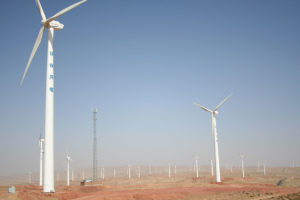
Wind farm, Ningxia, China
Source: Land Rover Our Planet, Flickr
In my Chapter ‘Under the Dome’ in the China Story Yearbook 2015, there was plenty of cause for pessimism surrounding China’s quest for low-carbon, green growth. While the news is not all good for 2016 (see Forums ‘Environmental Disasters’ and ‘Iron-Fisted Punishments’), there have been some positive environmental outcomes for China and the world as well. Domestically, the release of the Thirteenth Five-Year Plan in March 2016 strengthened China’s commitment to developing a low-carbon green economy (see Chapter 1 ‘What’s the Plan?‘). There is ample evidence to suggest that this commitment is real. In May 2016, Greenpeace declared that ‘China’s Thirteenth Five-Year Plan is quite possibly the most important document in the world in setting the pace of acting on climate change’. Greenpeace further noted that ‘2020 energy targets that would have seemed quite meaningful or even ambitious a few years ago have now become redundant’. Of the many figures they provide to support their positive assessment is the share of coal in China’s total energy mix, which is expected to fall below sixty-three percent in 2016 — a one-percentage-point annual drop since 2010, and only one percentage point above the target of sixty-two percent for 2020.
In early September, China announced its ratification of the Paris Agreement on climate change. By 3 October 2016, fifty-five countries, responsible for fifty-five percent of global greenhouse gas emissions, had ratified the agreement, allowing it to come into effect. China’s decision clearly encouraged a large number of other countries to follow suit — as of 5 October 2016, eighty-one countries had signed on. On 4 November 2016, thirty days after the fifty-five-country target was reached, the Paris Agreement entered into force. Despite its lack of binding targets, it is unquestionably a step in the right direction for global environmental change.
The greatest sign of hope lies in China’s advances in renewable energy, what John Mathews described in a recent Asia-Pacific Journal article as ‘China’s continuing renewable energy revolution’. Building on his previous work with Hao Tan, in which they argued that China has ‘overwhelming economic and energy security reasons for opting in favour of renewables, in addition to the obvious environmental benefits’, Mathews musters an impressive array of numbers to show that through 2015, China’s electric power system was still ‘greening faster than it [was] becoming black’ in terms of electric power generation, new generating capacity, and investment. If these trends continue, he argues that China will become ‘the world’s undisputed renewables superpower’ and could well become the world’s first ‘terawatt renewables powerhouse’ by the early 2020s. If — and it is a large if — China can both meet its own ambitious targets and export these trends to its partner countries in the One Belt One Road initiative (see the China Story Yearbook 2015: Pollution, Forum ‘One Belt One Road: International Development Finance with Chinese Characteristics’), and beyond, the international benefits could be tremendous.
China’s environmental track record over the past four decades, a period that has been broadly summarised as ‘growth at all costs’, has been far from perfect. Many people will argue that recent developments are too little too late. Yet the Chinese government’s plans, combined with mounting evidence that positive change is occurring on the ground, demonstrate a capacity for and commitment to greening the economy that environmentalists in advanced democratic countries including Australia and the US can only dream about. As of December 2016, I’d still place my money on the Chinese government playing a positive role in ‘lifting the dome’ in the decade ahead, both in China and internationally as well. Given an increasingly environmentally aware public, whose growing demand for greener living is reflected in ever-increasing numbers of environmental protests across the country, the preservation of Party power is at stake, and that’s the most powerful incentive of all.
Notes
Lauri Myllyvirta, ‘China is hitting its climate targets years ahead of schedule’, Greenpeace, 31 May 2016, online at: http://energydesk.greenpeace.org/2016/05/31/china-is-hitting-its-climate-targets-years-ahead-of-schedule/
John A. Mathews, ‘China’s continuing renewable energy revolution — latest trends in electric power generation’, The Asia Pacific Journal, vol.14, iss.17 (September 2016), online at: http://apjjf.org/2016/17/Mathews.html/


